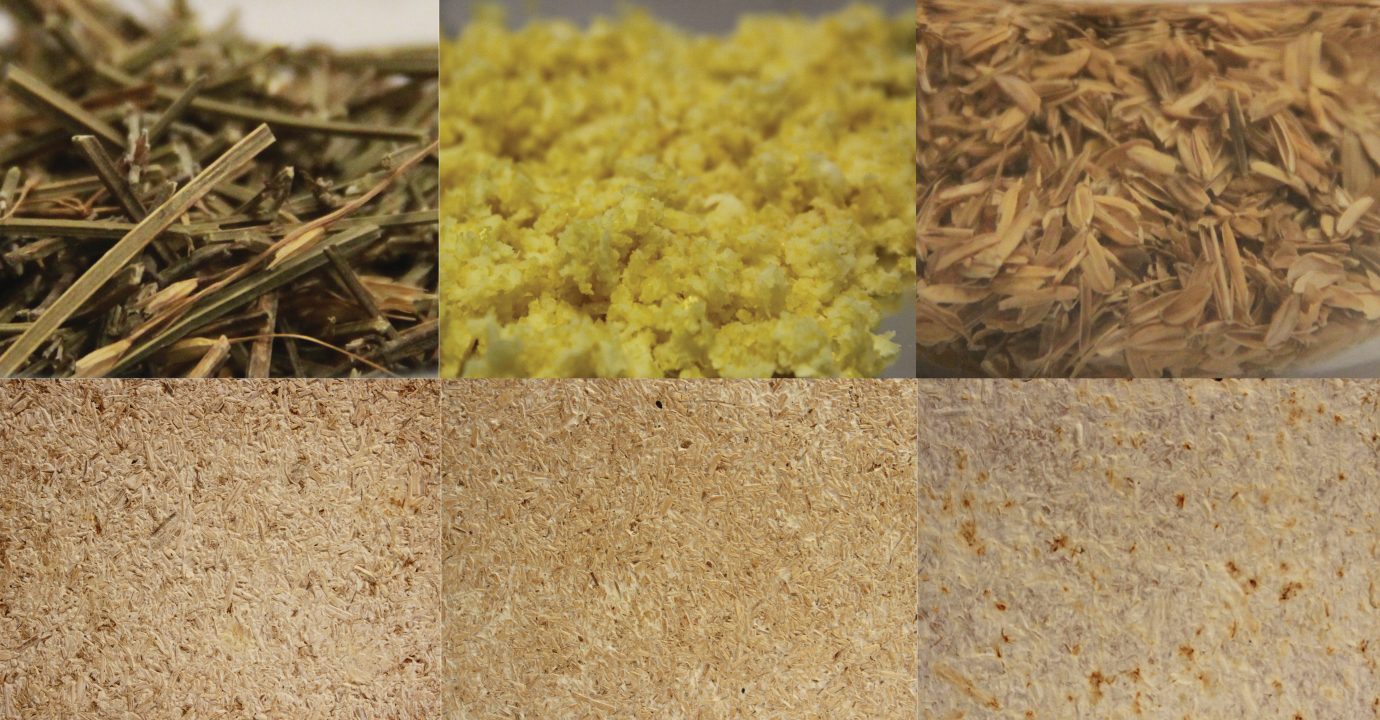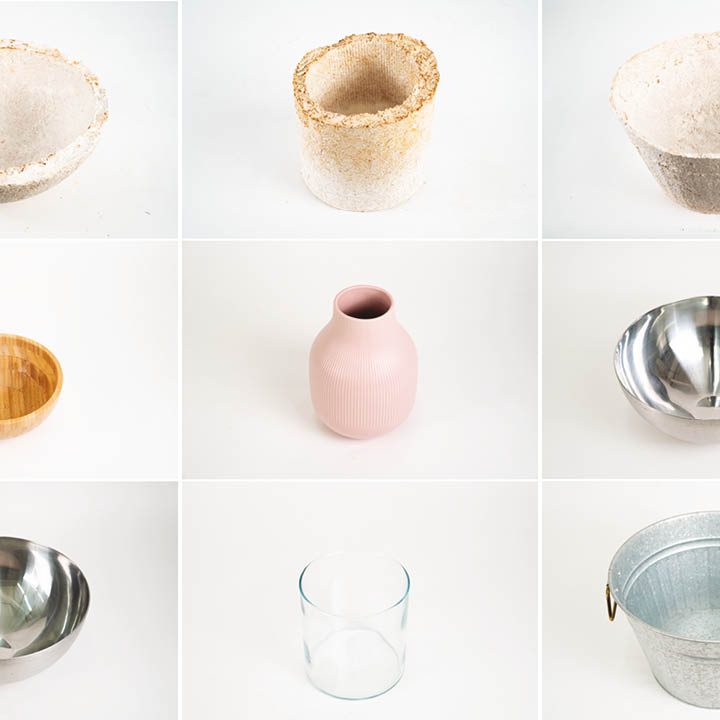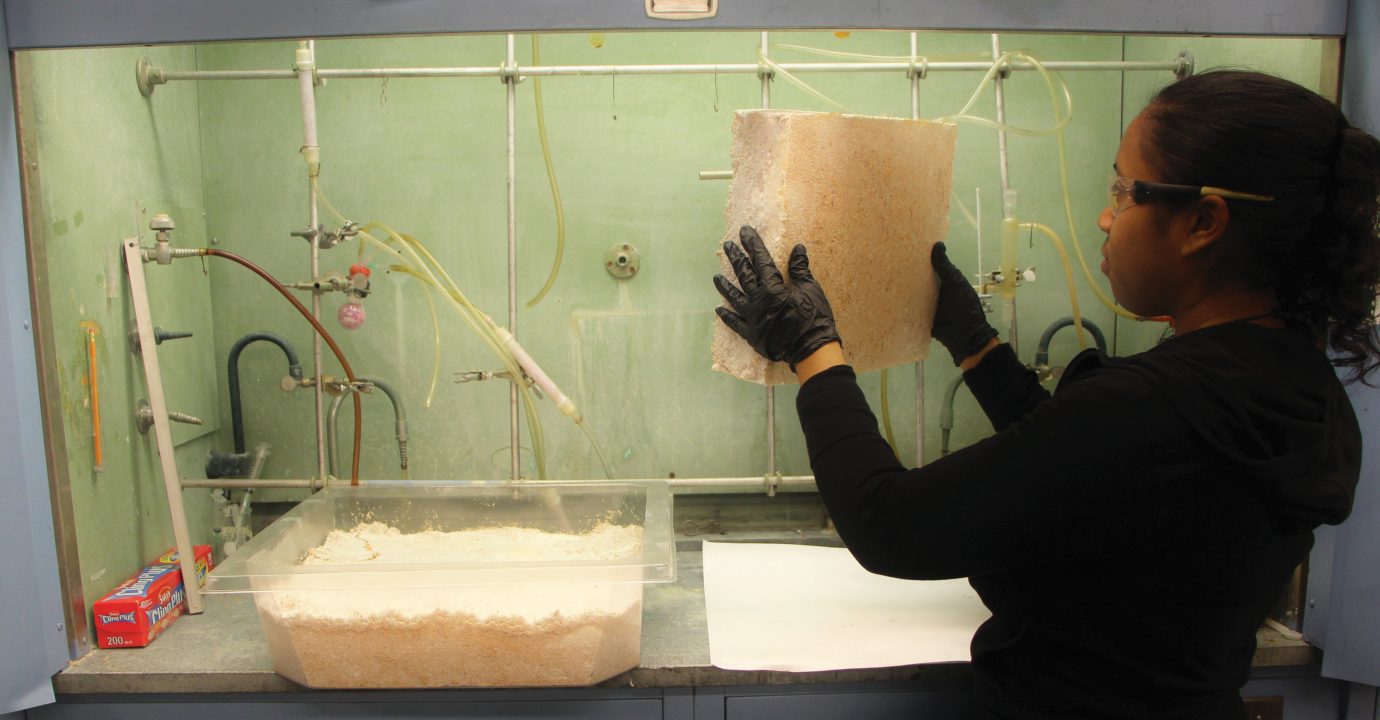
In her prototype for Housing the Human, titled Agrocologies, architectural technologist Mae-ling Lokko uses her research and experience in the industry of upcycling agrowaste into reliable building material, and scales it down to the intimate setting of a home. Her prototype envisions a near future in which preparing a meal would entail a new ritual: feeding kitchen waste to mycelium fungal colonies, in order to “grow” everyday objects. Bowls, plates, or even countertops could soon be home-grown in our own domestic environments, from the biowaste of our meals.
As homebrewing trends gain in popularity, grow-it-yourself kits for mycelium are only a small leap to make. The challenge, Lokko argues, is in purposefully transforming our habits around handling waste at home. With Agrocologies, she tackles this challenge with a thoughtful combination of science and creative experimentation.
What was the origin of the prototype you’re developing for Housing the Human? And how did your focus on proposing new domestic rituals come about?
I’ve been doing research on agricultural waste recycling for some time and started two startups, one based in New York and the other in Ghana, that take waste from agriculture to develop building materials and water treatment solutions. One of the biggest hurdles I’ve encountered in that work was that some of the economic and social barriers to upcycling couldn’t necessarily be addressed in business innovation. Overcoming such barriers needed to happen much closer to home, and much more intimately. And so Housing the Human felt like an opportunity to address some of these issues and to integrate upcycling practices into domestic rituals in an interesting way that also allowed public interaction and input.
What are some of those issues?
One of the biggest economic problems I found in the biomaterial industry is the fact that, because it’s waste, people don’t care about its quality. I thought about how can we actually preprocess these types of byproducts as valuable resources, and the kitchen seemed to me the most likely part of our homes; water and energy come in and out, and waste comes out. I wanted to actually prototype this kind of upcycling, and it had to be a ritual because the waste management practices we have today are mostly punitive. A ritual, on the other hand, is built into our daily lifestyle and can be aspirational, in the sense that the core of upcycling is looking at our spaces, things, and time that we have in our homes in a different way. Framing it in this manner was important for me.
Recycling laws are different around the world—how does that factor in to the prototype?
In places I’m familiar with, like West Africa and Southeast Asia, waste management systems in cities often do not include specific waste streams. For instance, you’re not allowed to put coconut husk waste in a municipal garbage bin. There’s no mechanism for actually throwing it out or getting rid of it—it has to be burned! This often happens illegally in public space at night. So I thought of it as an invitation to transform this material burden into an opportunity.

And how did mycelium come into the picture?
It was actually the result of a failure! One of the most promising bio-adhesives that I was working with at the time was derived from the dust-like pith you get from breaking the coconut husk. When heated and compressed, the pith can melt to form a robust uniform glue around the coconut fibers. But it was a failure because, depending on where you get this pith—Ghana, Sri Lanka, or the Philippines—its performance will differ. We would sometimes produce sheets that were as strong as oak, and sometimes they’d just crumble. That’s a huge problem if you’re trying to produce panels for construction. So we started looking at other bioadhesives that were performing well. Soy protein and mycelium were the emerging bioadhesives in upstate New York, where I was doing my PhD, and mycelium technology for large-scale packaging and furniture applications came out of the university where I was studying. So I thought, well, let’s just try this and explore whether it can be relatively consistent. And that opened up an entire world.
Bringing it back to the domestic realm, how would a family get their hands on mycelium for their kitchen-waste upcycling station?
The jump I’m making in Agrocologies right now is focused on the way a household could gain access to mycelium and support its entire life cycle while growing it relatively quickly and infection-free. I’m basing that on what I think could happen in the near future, inspired by different trends going on today. Right now, on the East Coast of the United States and in Amsterdam, you can buy grow-it-yourself mycelium kits in a pack, like flour or grain. They’re already inoculated, meaning that the mycelium in liquid or solid form is already mixed in. You buy the pack dry and store it in a cupboard for months, or you buy it wet, meaning it’s ready to grow within a few days and needs to be refrigerated. But this kit is not available everywhere in the world. There are active mycelium designers and collaborative groups that experiment with local strains, and although they don’t have the resources to make them perform as consistently as larger mycelium companies like Ecovative can, the knowledge they produce is something my project wants to support. At the festival, however, I’ll mainly use the strains that I’ve been working with and that have gone through robust approval to be used in our packaging and furniture.
Describe the building material that the mycelium produces: Does the result depend on the waste? Would the material stemming from a vegetarian household differ from, say, a meat-consuming household?
There is a limitation in terms of what the mycelium would eat—it has to be biomass. Which means it has to have lignin and cellulose. You do not feed it with animal products, or things could go wrong. So in a sense it supports a vegetarian or vegan lifestyle. The performance or the result of the material depends on what you feed it, so if you feed it with rice husk waste, it would perform very differently than if you’d feed it lemon peels. The strength may be different; how fast it grows may be different. An interesting aspect of working with a combination of food and agrowaste for me is that you can basically mix and match different types of food to affect the mycelium’s performance. And that goes hand in hand with cooking a meal using different ingredients. For now though, due to time restrictions, I’m focused on a certain group of food byproducts: lemon and citrus-based waste.
It sounds like, ideally, Agrocologies would come in a cookbook format!
We were thinking of having a Julia Child-style card, where you have a recipe for a meal on the front and on the back, the instructions for growing something out of the meal’s waste.
And to create an object, is it always necessary to work with molds?
Yes. And there are two types of molds I’m using for Housing the Human. One is household objects, where we looked specifically at the Ikea catalog, because it’s very universal. The objects become the molds: bowls, egg crates, plastic containers and so on, and the idea is to imagine new uses. The second type are “kits” that I’ve made for panels that go on a wall or a table. I kept them as abstract as possible in order not to impose a particular use. It can be very culturally-specific.

Let’s talk about the objects’ possible uses. Is the material water-resistant?
Mycelium itself deals with water very well, it is hydrophobic in nature, but if there’s a crack on the surface and water gets through to the lignocellulosic substrate, mold and other stuff can begin to thrive. One way to deal with it is to grow a layer of mycelium on the surface, which is nice, except it’s quite furry and it doesn’t necessarily have the surface of a countertop. Coatings are a huge part of this. At the moment we are open to using food-safe coating, like what you’d use to coat a wooden bowl. And then there’s more expensive biobased resins, like the ones used to coat surfboards, which are really robust. There’s a lot more research to pursue, and I’d like to focus on bacteria-based coatings.
And how about color? Can the resulting objects be dyed?
That’s something we’ve been trying to do for some time. I was initially exploring using the dyes from textile waste water—that would have fit in well with giving value to waste again—and with food coloring, to change the color of the mycelium biomass as it’s growing. But mycelium is one of the most effective bio remediation “technologies” there is; what it ends up doing is degrading things, including compounds that are colored, so everything would end up mushroom-white. We looked at how mushrooms produce color in nature, and sometimes it can be a sign of toxins released to the surface. But there are a few strains of fungi that are actually already colorful as mycelia, and we are currently exploring with one that is bright orange-pink. I’m doing that as part of a team at the Atelier Luma, the research branch of the Luma Foundation, where I have an active research project on mycelium, embedded in the local ecology of the Camargue region.

How far is the prototype from becoming applicable for domestic use?
One of my colleagues, a chemical engineer, and I were envisioning how one would actually buy it. Today, in some places, you can go to the grocery store and buy a pack of mycelium, but the idea that this can be readily available is taking inspiration from some of the home-brewing culture. If you buy a pack or vial of mycelium you can begin to scale and propagate it at home depending on what you need to grow. You may decide to grow a bowl, maybe a whole wall of mycelium panels. So our hope is that it becomes as widespread as that, but actually visualizing what the home environment or the rituals at home could be is hard to do in science- or engineering-based platforms. That’s why I think that Housing the Human is such a fun and rare opportunity.
What will happen at the festival? How will you convey the project to the audience?
I chose a space at radialsystem that evokes something like an apartment, in which I’m creating an abstraction of a kitchen and dining area, and on its boundary, a living room. Four performers are going to stage a dinner party, and some of the vegetable waste from cooking their meal is put aside. They dine, and at the end they take the waste, process it, and mold it into bowls. Fast forward to the next morning, the person who lives there wakes up, makes her coffee, and feeds her mushrooms with the coffee waste. So the idea is that there are different transformation pathways in the way of our homes for the mycelium. It’s a very domestic and casual setting. The performance only happens twice, and otherwise visitors are invited to interact with the kitchen. There will be a film, and the set-up will be filmed, so we can better understand how people interact with it.